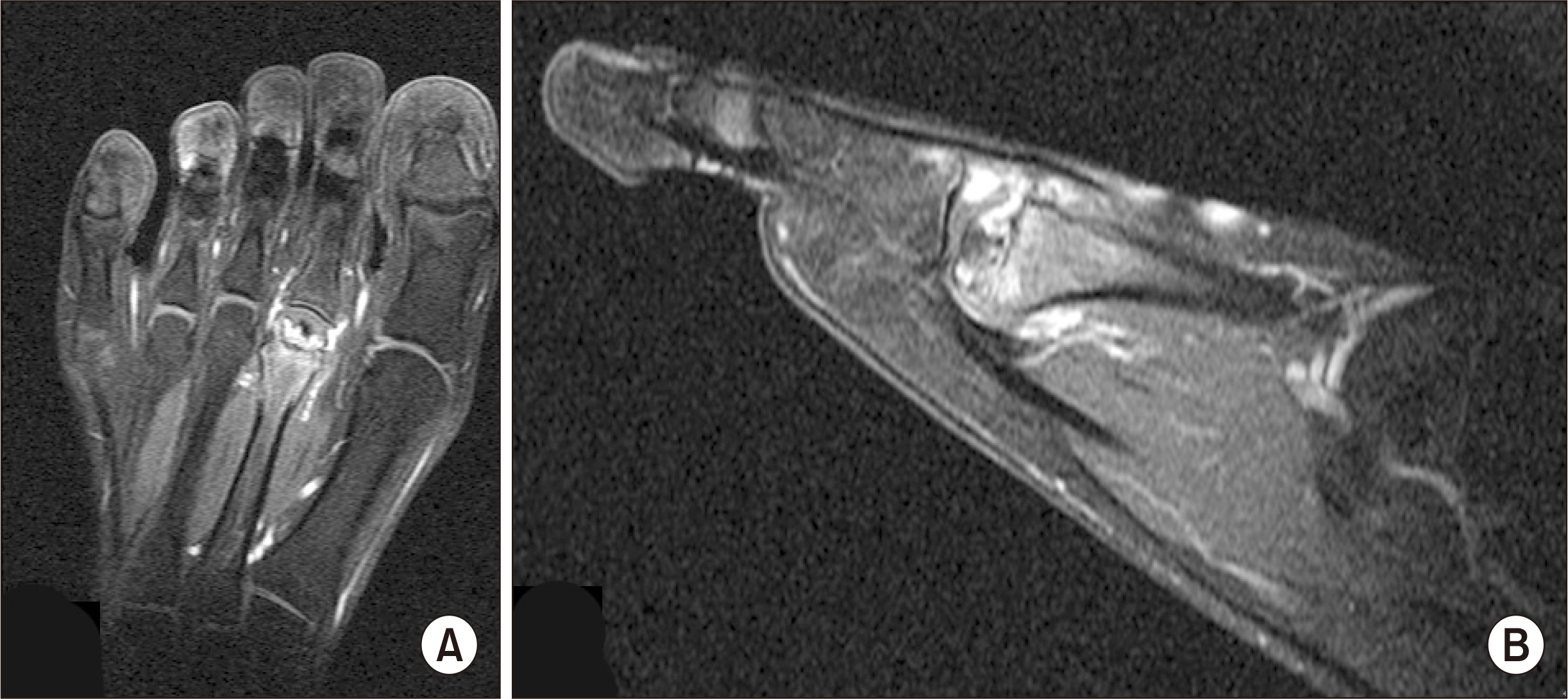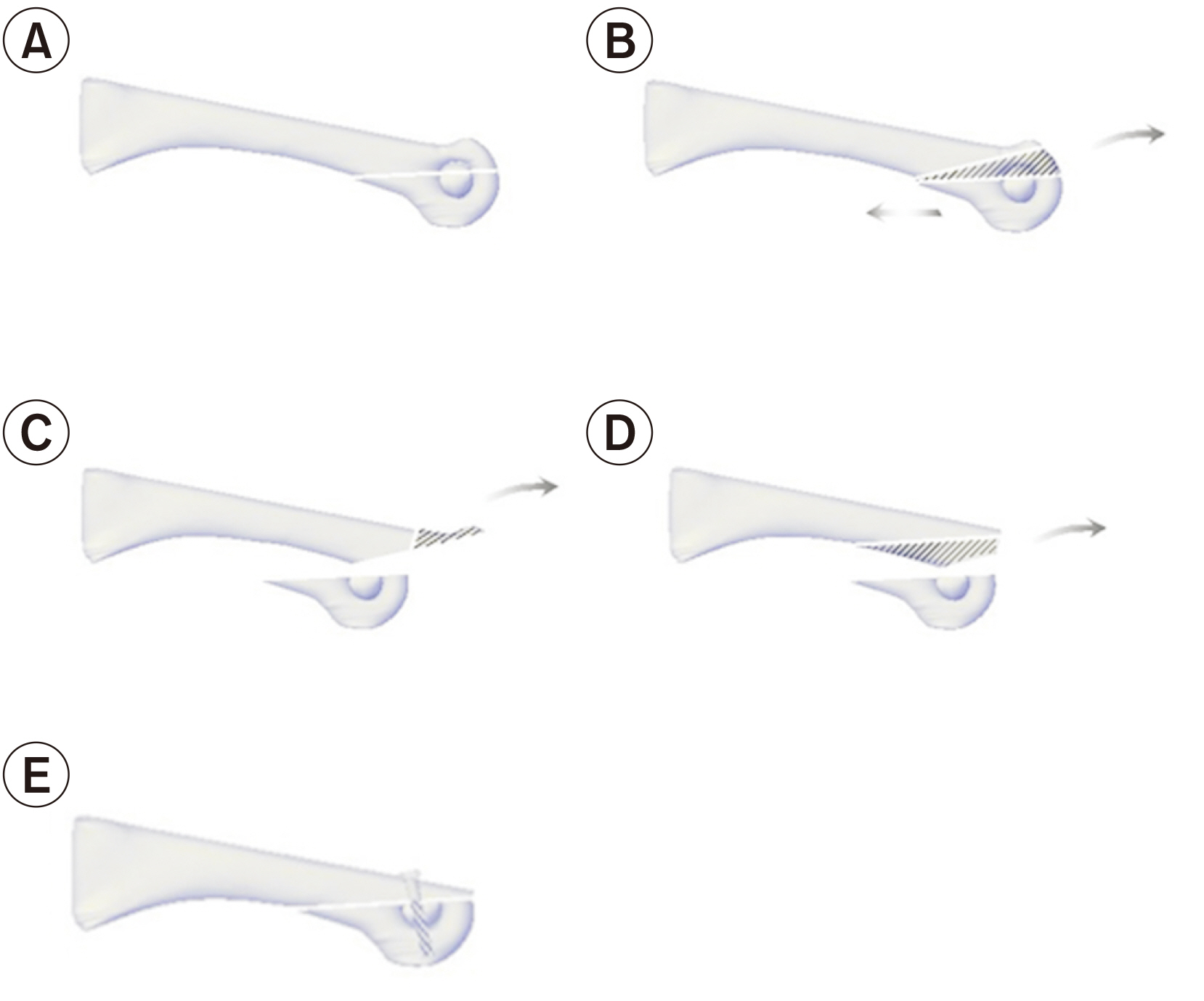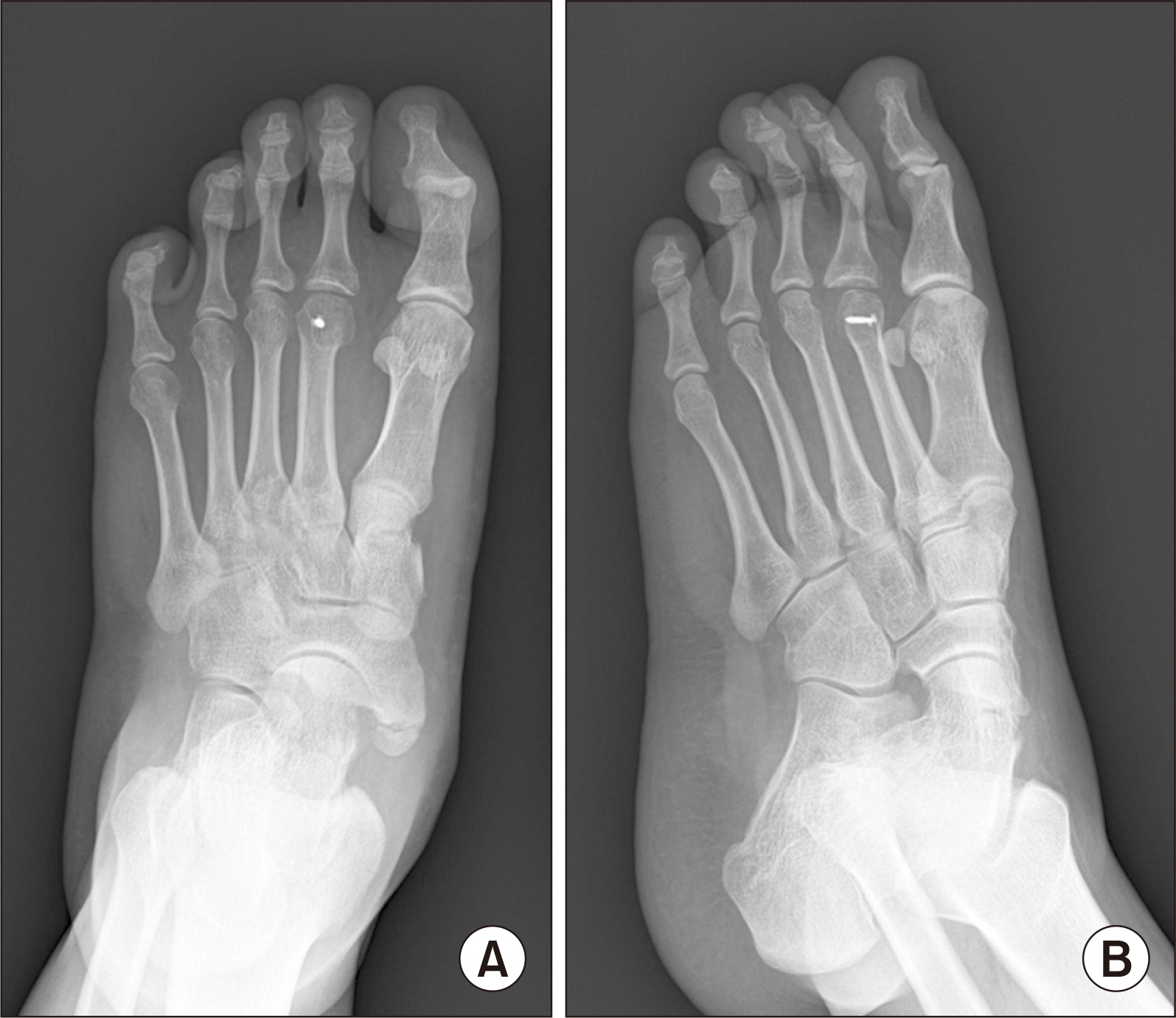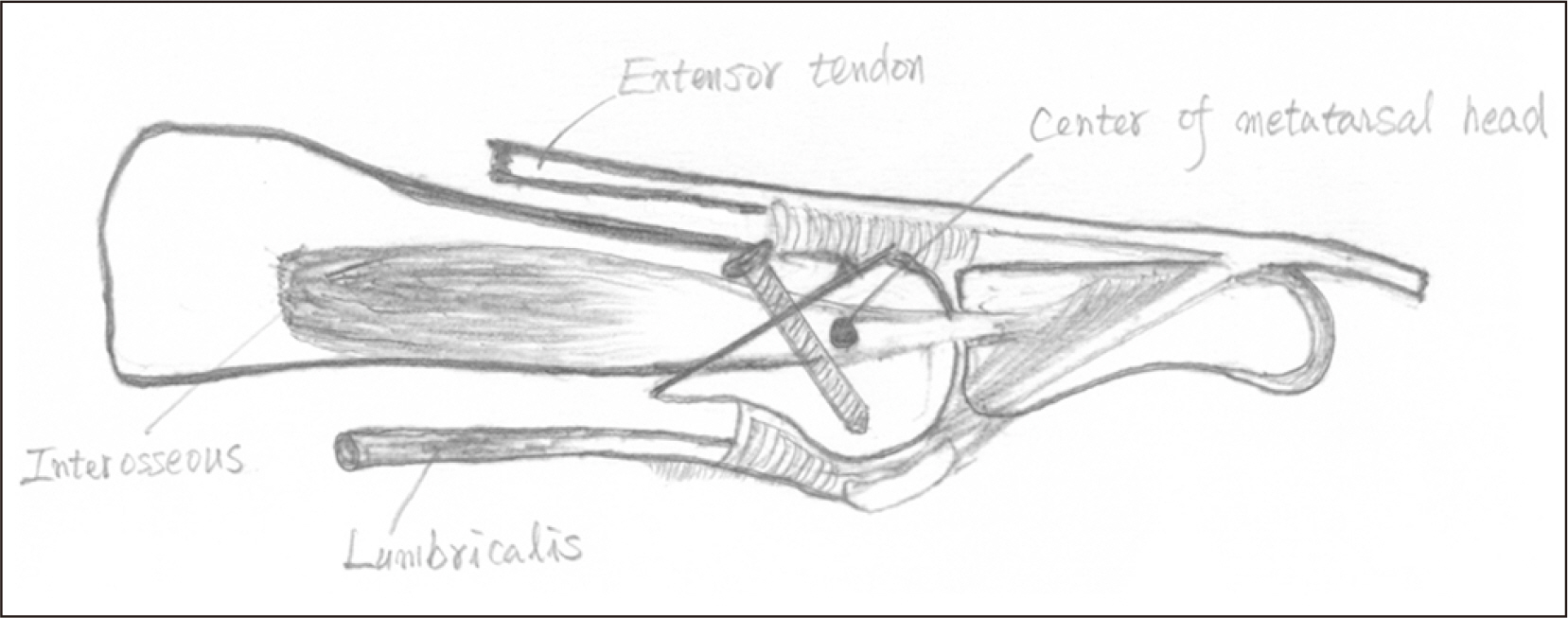J Korean Foot Ankle Soc.
2021 Dec;25(4):165-170. 10.14193/jkfas.2021.25.4.165.
Treatment of Freiberg’s Disease Using the Shortening Effect of the Modified Weil Osteotomy
- Affiliations
-
- 1Department of Orthopedic Surgery, Pohang St. Mary’s Hospital, Pohang, Korea
- KMID: 2523297
- DOI: http://doi.org/10.14193/jkfas.2021.25.4.165
Abstract
- Purpose
This study sought to evaluate the clinical effectiveness of the shortening effect of the modified Weil osteotomy for the treatment of Freiberg’s disease.
Materials and Methods
We reviewed 21 cases treated with the modified Weil osteotomy for Freiberg’s disease from November 2005 to June 2019. The average follow-up period was 32.5 months and the mean age of the patients was 38.3 years. The clinical results were analyzed using the American Orthopaedic Foot and Ankle Society (AOFAS) lesser metatarsophalangeal-interphalangeal scale, the visual analogue scale (VAS), and the range of motion (ROM) of the metatarsophalangeal joint. In the radiologic evaluation, the length of preoperative and postoperative metatarsal shortening was compared.
Results
The average AOFAS lesser metatarsophalangeal-interphalangeal scale showed an improvement from 60.5 preoperatively to 90.9 at the latest follow-up. VAS showed a decrease from 5.4 preoperatively to 0.9 at the latest follow-up. ROM of the affected metatarsophalangeal joint increased from 40.2 degrees preoperatively to 58.6 degrees at the latest follow-up. The mean length of metatarsal shortening was 6.7 mm. There was no transfer metatarsalgia, osteonecrosis, and definite joint space narrowing.
Conclusion
Modified Weil osteotomy with second layer cutting is an effective treatment option to restore the joint surface and painless joint motion for patients with Freiberg’s disease.
Figure
Reference
-
1. Carmont MR, Rees RJ, Blundell CM. 2009; Current concepts review: Freiberg's disease. Foot Ankle Int. 30:167–76. doi: 10.3113/FAI-2009-0167. DOI: 10.3113/FAI-2009-0167. PMID: 19254514.
Article2. Wiley JJ, Thurston P. 1981; Freiberg's disease. J Bone Joint Surg Br. 63:459. DOI: 10.2106/00004623-198163030-00022.3. Stanley D, Betts RP, Rowley DI, Smith TW. 1990; Assessment of etiologic factors in the development of Freiberg's disease. J Foot Surg. 29:444–7. PMID: 2258564.4. Jacob HAC, Zollinger H, Georgiev S. 1986. Could Koehler-Freiberg's disease be caused by biomechanical factors? Paper presented at: Fifth Meeting of the European Society of Biomechanics. Berlin, Germany. DOI: 10.1007/978-94-009-3355-2_76. 1986 Sep 8-10; p. 537–42.5. Jacob HA, Zollinger H. 1992; [Biomechanics of the foot--forces in the forefoot during walking and their clinical relevance]. Orthopade. 21:75–80. German. PMID: 1549342.6. Freiberg AA, Freiberg RA. 1995; Core decompression as a novel treatment for early Freiberg's infraction of the second metatarsal head. Orthopedics. 18:1177–8. doi: 10.3928/0147-7447-19951201-11. DOI: 10.3928/0147-7447-19951201-11. PMID: 8749298.
Article7. Freiberg JA. 1957; The diagnosis and treatment of common painful conditions of the foot. Instr Course Lect. 14:238–47. PMID: 13524958.8. Smillie IS. 1957; Freiberg's infraction (Köhler's second disease). J Bone Joint Surg Br. 39:580. doi: 10.1302/0301-620X.39B3.579. DOI: 10.1302/0301-620X.39B3.579.9. Smith TW, Stanley D, Rowley DI. 1991; Treatment of Freiberg's disease. A new operative technique. J Bone Joint Surg Br. 73:129–30. doi: 10.1302/0301-620X.73B1.1991746. DOI: 10.1302/0301-620X.73B1.1991746. PMID: 1991746.
Article10. Kinnard P, Lirette R. 1991; Freiberg's disease and dorsiflexion osteotomy. J Bone Joint Surg Br. 73:864–5. doi: 10.1302/0301-620X.73B5.1894683. DOI: 10.1302/0301-620X.73B5.1894683. PMID: 1894683.
Article11. Chao KH, Lee CH, Lin LC. 1999; Surgery for symptomatic Freiberg's disease: extraarticular dorsal closing-wedge osteotomy in 13 patients followed for 2-4 years. Acta Orthop Scand. 70:483–6. doi: 10.3109/17453679909000985. DOI: 10.3109/17453679909000985. PMID: 10622482.
Article12. Lee SK, Chung MS, Baek GH, Oh JH, Lee YH, Gong HS. 2007; Treatment of Freiberg disease with intra-articular dorsal wedge osteotomy and absorbable pin fixation. Foot Ankle Int. 28:43–8. doi: 10.3113/FAI.2007.0008. DOI: 10.3113/FAI.2007.0008. PMID: 17257537.
Article13. Lui TH. 2007; Arthroscopic interpositional arthroplasty for Freiberg's disease. Knee Surg Sports Traumatol Arthrosc. 15:555–9. doi: 10.1007/s00167-006-0189-4. DOI: 10.1007/s00167-006-0189-4. PMID: 16909297.
Article14. McGlamry ED, Ruch JA. 1976; Status of implant arthroplasty of the lesser metatarsophalangeal joints. J Am Podiatry Assoc. 66:155–64. doi: 10.7547/87507315-66-3-155. DOI: 10.7547/87507315-66-3-155. PMID: 1254894.
Article15. Cerrato RA. 2011; Freiberg's disease. Foot Ankle Clin. 16:647–58. doi: 10.1016/j.fcl.2011.08.008. DOI: 10.1016/j.fcl.2011.08.008. PMID: 22118235.
Article16. Seybold JD, Zide JR. 2018; Treatment of Freiberg disease. Foot Ankle Clin. 23:157–69. doi: 10.1016/j.fcl.2017.09.011. DOI: 10.1016/j.fcl.2017.09.011. PMID: 29362030.
Article17. Smillie IS. 1967; Treatment of Freiberg's infraction. Proc R Soc Med. 60:29–31. doi: 10.1177/003591576706000117. DOI: 10.1177/003591576706000117.
Article18. Gauthier G, Elbaz R. Freiberg's infraction: a subchondral bone fatigue fracture. A new surgical treatment. Clin Orthop Relat Res. 1979; (142):93–5. doi: 10.1097/00003086-197907000-00015. DOI: 10.1097/00003086-197907000-00015. PMID: 498654.19. Kinnard P, Lirette R. 1989; Dorsiflexion osteotomy in Freiberg's disease. Foot Ankle. 9:226–31. doi: 10.1177/107110078900900504. DOI: 10.1177/107110078900900504. PMID: 2731834.
Article20. Kim J, Choi WJ, Park YJ, Lee JW. 2012; Modified Weil osteotomy for the treatment of Freiberg's disease. Clin Orthop Surg. 4:300–6. doi: 10.4055/cios.2012.4.4.300. DOI: 10.4055/cios.2012.4.4.300. PMID: 23205240. PMCID: PMC3504695.
Article21. Capar B, Kutluay E, Müjde S. 2007; [Dorsal closing-wedge osteotomy in the treatment of Freiberg's disease]. Acta Orthop Traumatol Turc. 41:136–9. Turkish. PMID: 17483650.22. Lee HS, Kwon SY, Kim DW, Chung JW. 2011; Weil osteotomy for Freiberg's disease. J Korean Foot Ankle Soc. 15:217–22.23. Lee JY, Kim WH, Jung S, Yang SH. 2016; Outcome of extraarticular dorsal closing wedge osteotomy for Freiberg's disease. J Korean Foot Ankle Soc. 20:126–30. doi: 10.14193/jkfas.2016.20.3.126. DOI: 10.14193/jkfas.2016.20.3.126.
Article24. Barouk LS. 2005. Forefoot reconstruction. 2nd ed. Springer-Verlag France;Paris: p. 129–38. DOI: 10.1007/2-287-28937-2. PMID: 15831263.
- Full Text Links
- Actions
-
Cited
- CITED
-
- Close
- Share
- Similar articles
-
- Modified Weil Osteotomy for the Treatment of Freiberg's Disease
- Weil Osteotomy for Freiberg's Disease
- Operative Treatment of the Bilateral 1,4th Brachymetatarsia with Painful Callosity and Hallux Varus using Massive Metatarsal Axial Shortening: A Case Report
- Dorsal Closing Wedge Osteotomy in Freiberg's Disease
- Dorsal Wedge Osteotomy Using Bioabsorbable Pins for the Treatment of Freiberg's Disease






